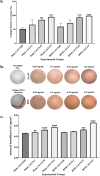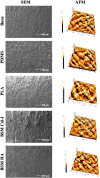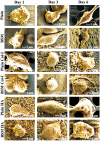Effects of bone surface topography and chemistry on macrophage polarization
- PMID: 38830871
- PMCID: PMC11148019
- DOI: 10.1038/s41598-024-62484-3
Effects of bone surface topography and chemistry on macrophage polarization
Abstract
Surface structure plays a crucial role in determining cell behavior on biomaterials, influencing cell adhesion, proliferation, differentiation, as well as immune cells and macrophage polarization. While grooves and ridges stimulate M2 polarization and pits and bumps promote M1 polarization, these structures do not accurately mimic the real bone surface. Consequently, the impact of mimicking bone surface topography on macrophage polarization remains unknown. Understanding the synergistic sequential roles of M1 and M2 macrophages in osteoimmunomodulation is crucial for effective bone tissue engineering. Thus, exploring the impact of bone surface microstructure mimicking biomaterials on macrophage polarization is critical. In this study, we aimed to sequentially activate M1 and M2 macrophages using Poly-L-Lactic acid (PLA) membranes with bone surface topographical features mimicked through the soft lithography technique. To mimic the bone surface topography, a bovine femur was used as a model surface, and the membranes were further modified with collagen type-I and hydroxyapatite to mimic the bone surface microenvironment. To determine the effect of these biomaterials on macrophage polarization, we conducted experimental analysis that contained estimating cytokine release profiles and characterizing cell morphology. Our results demonstrated the potential of the hydroxyapatite-deposited bone surface-mimicked PLA membranes to trigger sequential and synergistic M1 and M2 macrophage polarizations, suggesting their ability to achieve osteoimmunomodulatory macrophage polarization for bone tissue engineering applications. Although further experimental studies are required to completely investigate the osteoimmunomodulatory effects of these biomaterials, our results provide valuable insights into the potential advantages of biomaterials that mimic the complex microenvironment of bone surfaces.
Keywords: Biomimetic; Bone surface topography; Macrophage polarization; Macrophages; Soft lithography; Surface modification osteoimmunomodulation.
© 2024. The Author(s).
Conflict of interest statement
The authors declare no competing interests.
Figures







Similar articles
-
The Chitosan/Agarose/NanoHA Bone Scaffold-Induced M2 Macrophage Polarization and Its Effect on Osteogenic Differentiation In Vitro.Int J Mol Sci. 2021 Jan 23;22(3):1109. doi: 10.3390/ijms22031109. Int J Mol Sci. 2021. PMID: 33498630 Free PMC article.
-
Collagen patches releasing phosphatidylserine liposomes guide M1-to-M2 macrophage polarization and accelerate simultaneous bone and muscle healing.Acta Biomater. 2024 Oct 1;187:51-65. doi: 10.1016/j.actbio.2024.08.012. Epub 2024 Aug 17. Acta Biomater. 2024. PMID: 39159714
-
Phosphatidylserine liposome multilayers mediate the M1-to-M2 macrophage polarization to enhance bone tissue regeneration.Acta Biomater. 2022 Dec;154:583-596. doi: 10.1016/j.actbio.2022.10.024. Epub 2022 Oct 21. Acta Biomater. 2022. PMID: 36273800
-
Delivery strategies to control inflammatory response: Modulating M1-M2 polarization in tissue engineering applications.J Control Release. 2016 Oct 28;240:349-363. doi: 10.1016/j.jconrel.2016.01.026. Epub 2016 Jan 14. J Control Release. 2016. PMID: 26778695 Free PMC article. Review.
-
Mitochondria-Targeted Biomaterials-Regulating Macrophage Polarization Opens New Perspectives for Disease Treatment.Int J Nanomedicine. 2025 Feb 4;20:1509-1528. doi: 10.2147/IJN.S505591. eCollection 2025. Int J Nanomedicine. 2025. PMID: 39925677 Free PMC article. Review.
Cited by
-
Topography-based implants for bone regeneration: Design, biological mechanism, and therapeutics.Mater Today Bio. 2025 Jul 13;34:102066. doi: 10.1016/j.mtbio.2025.102066. eCollection 2025 Oct. Mater Today Bio. 2025. PMID: 40735704 Free PMC article. Review.
-
Bioactive Glass and Melittin Thin Films Deposited by MAPLE for Titanium Implant Functionalization.Materials (Basel). 2025 May 21;18(10):2410. doi: 10.3390/ma18102410. Materials (Basel). 2025. PMID: 40429147 Free PMC article.
-
The effect of 3D printing technology combined with Morse taper and platform switching design on microleakage performance of dental implants.Odontology. 2025 Jul 14. doi: 10.1007/s10266-025-01152-y. Online ahead of print. Odontology. 2025. PMID: 40659999
-
Development of Biomaterials to Modulate the Function of Macrophages in Wound Healing.Bioengineering (Basel). 2024 Oct 12;11(10):1017. doi: 10.3390/bioengineering11101017. Bioengineering (Basel). 2024. PMID: 39451393 Free PMC article. Review.
-
Decoding biomaterial-associated molecular patterns (BAMPs): influential players in bone graft-related foreign body reactions.PeerJ. 2025 Apr 22;13:e19299. doi: 10.7717/peerj.19299. eCollection 2025. PeerJ. 2025. PMID: 40292103 Free PMC article. Review.
References
MeSH terms
Substances
Grants and funding
LinkOut - more resources
Full Text Sources

